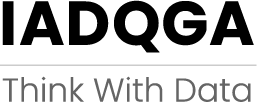Statistical Literacy
“Statistical literacy” is the ability to understand and reason with statistics and data.
The need for statistical literacy is being accelerated by the driving demand for data literacy and critical thinking. While we are continuously being exposed to statistics (quantitative analysis) in our personal lives, statistical literacy is becoming a new workplace requirement. Credible statistical information is necessary to make informed decisions.
The goal of the International Association for Data Quality, Governance and Analytics (IADQGA) is committed to satisfying these statistics based needs. The approach will be broad to include statistical reasoning and thinking. (The often differentiation between statistics meaning mathematical models and processes and “statistical literacy” meaning “statistical reasoning” and “statistical thinking” (See Definitions Section) are combined in our approach to statistical literacy.) As such, statistical literacy will involve information that is communicated through text, maps, graphical and tabular displays, numbers and symbols. The need by students and working professionals in all fields of the basic and advanced concepts and techniques.
The level of statistical competence varies by profession and job classification but strong basic statistical knowledge is a required skill.
Statistical literacy can be segmented into three (3) levels:
Basic statistical literacy will have an awareness of, understanding and appreciate the type of data sources used (survey or actual process data), be able to find definitions of statistical terms, and understand basic statistical measures and graph representations of data. (U.N. Economic Commission For Europe – Making data Meaningful)
Intermediate statistical literacy will understand and have an appreciation of the limitations of various methods used, understand the more commonly used statistical concepts and terms, understand variability and uncertainty, and be able to interpret probability statements associated with sample estimates. (U.N. Economic Commission For Europe – Making data Meaningful)
Advanced statistical literacy will be able to understand the more sophisticated statistical terminology, understand sampling errors and non-sampling errors, understand what constitutes a valid statistical study, make valid statistical inferences, and critically assess claims that are made about the data. (U.N. Economic Commission For Europe – Making data Meaningful)
The IADQGA’s focus is to provide its members with:
Basic data awareness
The importance of data quality
A working knowledge and understanding of basic statistical concepts, calculations and terminology
Basic data collection techniques
Basic descriptive statistics
Basic predictive statistics
Statistical result interpretation
Basic statistical result communications & visualization
Statistical Calculation
The method of calculating key statistics will be downplayed and the focus will be on understanding and interpreting the statistical results. (Statistical calculations will be demonstrated and performed utilizing EXCEL (The most prominently available software to data cleaning, organizing and analysis.)
Statistical literacy is a science of method – (the sciences of method study on how we think – Rand, 1966). The sciences of method can be classified by their focus (words vs numbers) and by their method (deductive vs inductive).
Method of Reasoning
Critical Thinking
Critical thinking is required by every organization whether for profit or not-for- profit. An organizations ability to have its members at all levels of the organization to perform critical thinking is critical to an organizations ongoing success.
Those organizations that have the ability to perform critical thinking will differentiate themselves and will command a superior competitive position.
Both “Data” and ‘Statistical” literacy are the building blocks for critical thinking.
(Source: IASSIST Quarterly – Summer/Fall 2004)
Definitions
Statistical Literacy – Statistical literacy involves understanding and using the basic language and tools of statistics: knowing what statistical terms mean, understanding the use of statistical symbols, and recognizing and being able to interpret representations of data. (Source – Assessment Resource Tools for Improving Statistical Thinking)
Statistical Reasoning – Statistical reasoning is the way people reason with statistical ideas and make sense of statistical information. Statistical reason my involve connecting one concept to another (e.g., center and spread) or may combine ideas about data and chance. Reasoning means understanding and being able to explain statistical processes, and being able to fully interpret statistical results. (Source – Assessment Resource Tools for Improving Statistical Thinking)
Statistical Thinking – Statistical thinking involves an understanding of why and how statistical investigations are conducted. This includes recognizing and understanding the entire investigative process (from question posing to data collection to choosing analyses to testing assumptions, etc.), understanding how models are used to simulate random phenomena, understanding how data are produced to estimate probabilities, recognizing how, when and why existing inferential tools can be used, and being able to understand and utilize the context of a problem to plan and evaluate investigations and to draw conclusions. (Source – Assessment Resource Tools for Improving Statistical Thinking)



